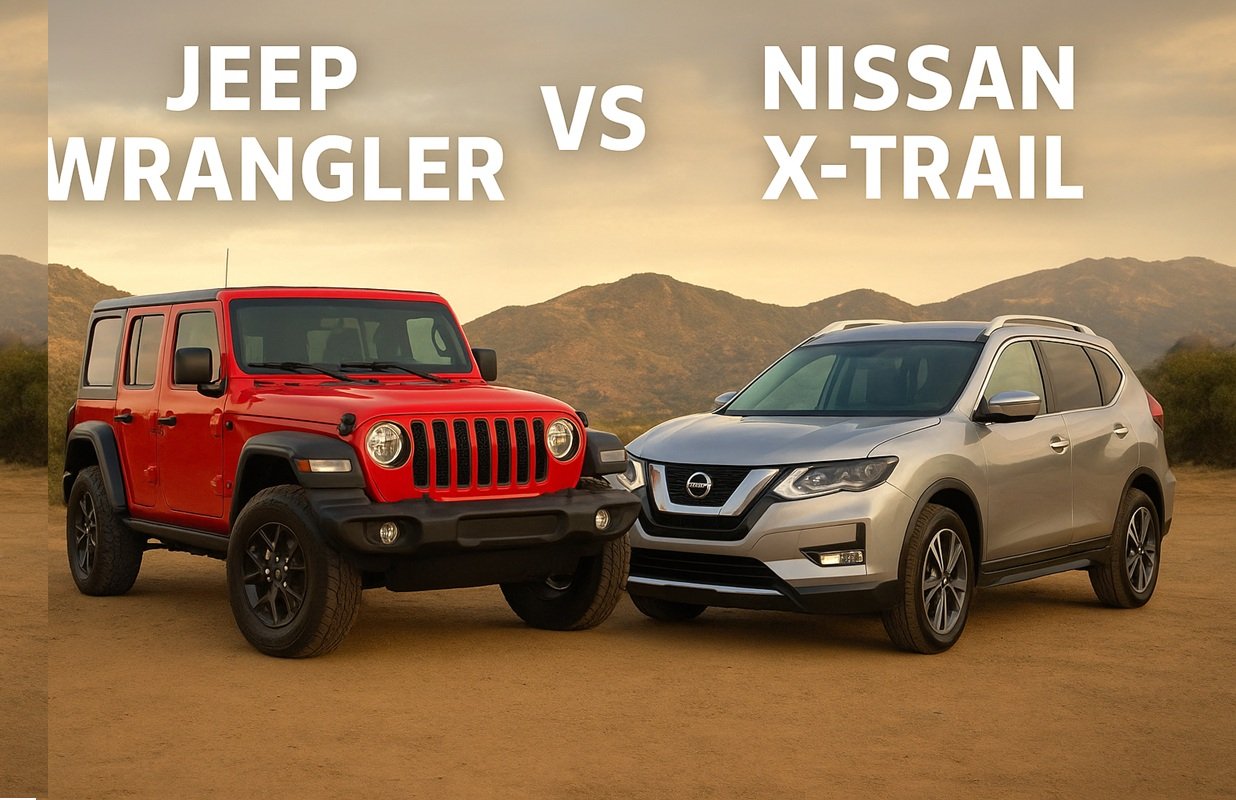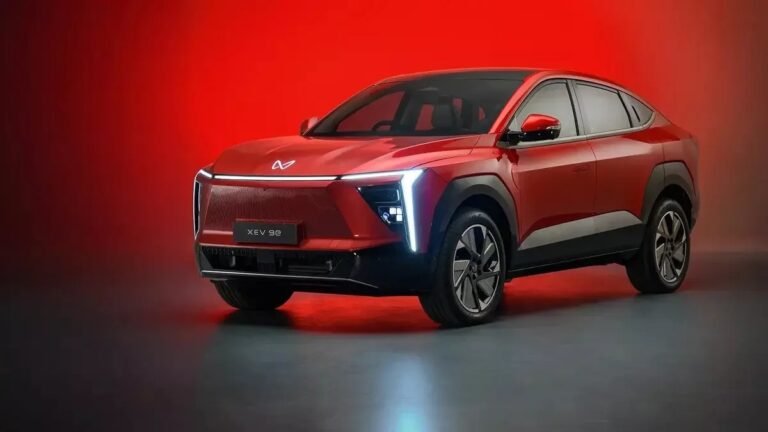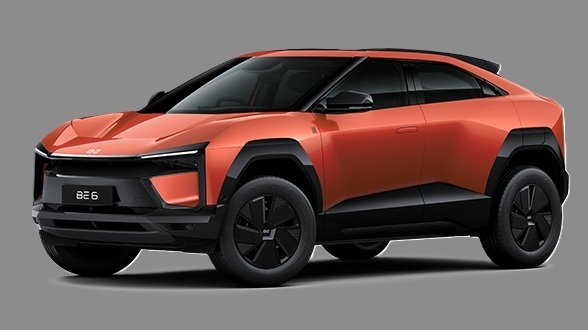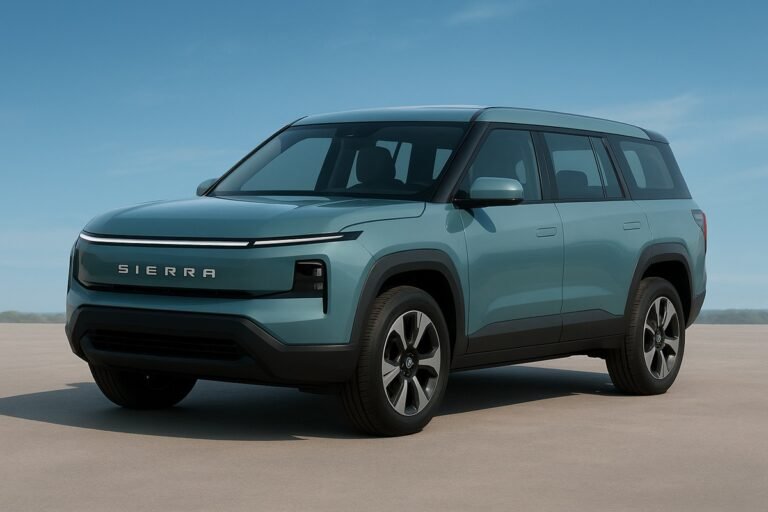
Jeep Wrangler vs Nissan X-Trail
Jeep Wrangler vs Nissan X-Trail – Battle of SUVs for Adventure and Comfort.
In the competitive SUV segment, the Jeep Wrangler vs Nissan X-Trail stand out as two of the most popular choices for customers seeking a mix of adventure capability and everyday usability. While both SUVs serve similar purposes in some respects, they cater to slightly different audiences and priorities. The Wrangler is celebrated for its rugged off-road prowess, whereas the X-Trail emphasizes comfort, technology, and family-oriented features. Let’s dive deep into how these two models compare across design, performance, off-road capability, comfort, technology, and pricing.
Design and Aesthetics
The Jeep Wrangler is an iconic SUV with a boxy, muscular design that screams off-road adventure. It carries forward the legacy of its military-inspired predecessors, featuring a seven-slot front grille, round headlamps, high ground clearance, and removable doors and roof options in some variants. The Wrangler’s appearance is unapologetically rugged, attracting enthusiasts who prefer a bold, no-nonsense look and an unmistakable presence on and off the road.
On the other hand, the Nissan X-Trail opts for a more modern, urban-friendly design. It sports sleek lines, a V-Motion grille, sharp LED headlamps, and a more aerodynamic profile, giving it a polished, sophisticated look suitable for city life and family use. The X-Trail emphasizes versatility and elegance rather than an aggressive off-road character, appealing to customers who prioritize daily comfort and style over hardcore off-roading.
Performance and Powertrain
Jeep Wrangler vs Nissan X-Trail :
The Jeep Wrangler is engineered with off-road performance in mind. It typically comes with powerful engine options such as a 2.0-liter turbocharged inline-four or a 3.6-liter V6 petrol engine, both mated to robust 4×4 systems. The Wrangler produces between 270 to 285 horsepower, depending on the variant, with ample torque to tackle steep inclines, mud trails, and rough terrains. Manual and automatic transmission options are available, giving purists the choice to experience driving control directly.
The Nissan X-Trail, however, leans towards a balanced powertrain optimized for everyday driving comfort and efficiency. It offers a 2.0-liter naturally aspirated petrol engine or a 2.5-liter petrol option, paired with a CVT (Continuously Variable Transmission) or a conventional automatic gearbox. Power output ranges between 150 to 170 horsepower, which is sufficient for city driving and light off-road use but doesn’t match the Wrangler’s off-road strength.
Off-Road Capability
The Jeep Wrangler is designed for serious off-road enthusiasts. It comes standard with features such as high ground clearance (up to 250 mm), solid axles, locking differentials, skid plates, and specialized off-road modes like Rock-Trac or Command-Trac 4×4 systems. It is capable of fording streams, climbing rocks, and navigating deep mud, making it one of the best in its class for adventure seekers who frequently venture off the beaten path.
Conversely, the Nissan X-Trail is more suited for light off-roading and rough roads rather than hardcore adventures. It offers an intelligent 4×4 system that automatically adjusts power distribution between front and rear wheels based on road conditions. While this makes it reliable on slippery roads and uneven city outskirts, it lacks features like locking differentials or specialized off-road driving modes found in the Wrangler. The ground clearance is moderate, around 210 mm, sufficient for urban potholes and gravel paths but not for serious trails.
Interior Comfort and Practicality
Inside the cabin, the Nissan X-Trail shines with a well-appointed, comfortable interior designed for family use. It offers soft-touch materials, ergonomic seating, a spacious 5 to 7-seat configuration, and ample boot space, making it ideal for long road trips or daily commutes. The ride quality is smooth, thanks to its suspension setup tuned for comfort rather than ruggedness. Key features include a touchscreen infotainment system, Apple CarPlay and Android Auto, automatic climate control, and a suite of driver-assist technologies.
The Jeep Wrangler’s interior is more utilitarian. It focuses on durability and simplicity, with hard-wearing materials designed to withstand the rigors of outdoor use. While newer models have introduced improved infotainment systems with touchscreen displays and smartphone integration, the overall experience is less refined compared to the X-Trail. Seating is comfortable but more upright, reflecting its rugged intent. Boot space is decent but somewhat reduced by the design, especially with removable roof and door options.
Safety and Technology
Jeep Wrangler vs Nissan X-Trail : In terms of safety, both vehicles come equipped with essential features like multiple airbags, ABS with EBD, and stability control. The Nissan X-Trail edges ahead by offering a more comprehensive suite of advanced safety technologies such as Blind Spot Monitoring, Rear Cross Traffic Alert, Intelligent Emergency Braking, and adaptive cruise control.
The Jeep Wrangler is more focused on mechanical robustness than driver-assist tech. While it offers standard safety features, advanced driver aids are available mostly in higher trims and are not as comprehensive as the X-Trail’s suite.
Fuel Efficiency and Running Costs
Jeep Wrangler vs Nissan X-Trail : The Nissan X-Trail delivers better fuel efficiency, averaging around 15–17 km per liter, depending on driving conditions, which makes it an economical option for daily commuting and long drives. Its lower running costs, combined with a smooth CVT transmission, make it attractive for budget-conscious families.
The Jeep Wrangler, due to its heavier build, larger engine, and off-road focus, consumes more fuel, typically offering around 10–12 km per liter. This makes it less practical for everyday use if fuel economy is a primary concern. Maintenance costs are also higher, especially for 4×4 components and specialized parts.
Price Comparison
In India, the Jeep Wrangler is priced significantly higher, reflecting its niche positioning and rugged capabilities. Expect the Wrangler to start around ₹60–70 lakh, depending on the variant and optional features.
The Nissan X-Trail is much more affordable, priced in the range of ₹35–45 lakh, making it a compelling choice for families seeking a comfortable SUV with occasional adventure capability.
Conclusion
The Jeep Wrangler vs Nissan X-Trail serve different purposes despite both being SUVs. The Wrangler is a purpose-built off-roader for adventure enthusiasts who demand extreme capability and don’t mind sacrificing some daily comfort or economy. In contrast, the X-Trail is an all-rounder, balancing urban comfort, family utility, and light off-road competence.
For buyers who prioritize rugged off-road adventures, removable roofs, and iconic styling, the Jeep Wrangler stands unmatched. However, for practical families seeking a reliable, tech-rich, comfortable SUV for urban and light adventure use, the Nissan X-Trail emerges as the smarter choice.
Last Updated on 15 September 2025.
See also this: Maruti FRONX vs Toyota Taisor Bold Petrol Crossover Meets .






